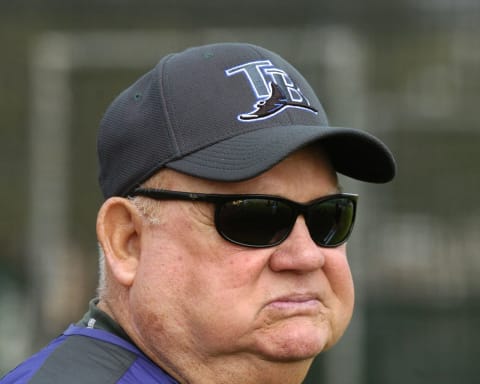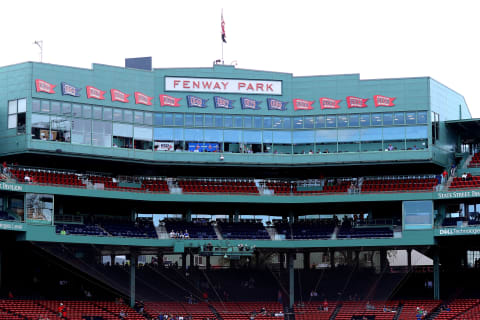Red Sox Memories: A look at four previous managers and a new one


The Boston Red Sox have a new manager due to a set of circumstances few saw coming. Now a look at four managers from Red Sox past and how they failed and succeeded.
Baseball players come in all shapes and sizes as the sport is quite democratic in the physical qualities of players. A behemoth first basemen next to a diminutive by comparison second baseman. As with any organization, the temperaments can also be as diverse with passive players to those with extreme volatility. This also applies to the intellectual capabilities of understanding the game and applying the right decision-making. There are players simply lack baseball smarts. All of this applies to managers who are usually culled from the player pool.
The first Red Sox manager from deep within what is left of my functioning memories was Lou Boudreau (1952-53) who was for Boston – rather briefly – a player-manager. Since that time I have seen many take the helm with the result eventually being canned or in the case of Pinky Higgins, his managerial incompetence was rewarded with a promotion to general manager. Being a drinking pal with the owner certainly had advantages. I will refrain – and it is difficult – with Higgins’s legacy of racism.
My focus will not be targeting this century but will focus on certain select managers that left an impression both favorable and unfavorable. As with much in the history of baseball information seeps out that sheds a new perspective or solidifies one that already existed. Now a look at my hit list of four different managers and their success and/or failures. The last frame will be incomplete since it will be about the latest entry to the Red Sox extensive managerial list.

Dick Williams
Major League Baseball players had a unique opportunity for decades and that was membership during the season in an exclusive country club. This club’s approach was unique in that it paid its members and not much was expected in return except to possibly play catch and drink with the owner. Entrance to the club was by initiation meaning either being traded or signed by the Boston Red Sox. Unfortunately, the reality is this is not much of an exaggeration of the Red Sox for far too many years.
This changed dramatically in 1967 when Dick Williams was hired to manage the Red Sox. As a player, Williams drifted through both the American and National Leagues hitting a career .260 as a role player. Williams’s last two seasons as a player were with the Red Sox (1963-64) and he left an impression on the organization as possible managerial material.
More from BoSox Injection
- Bizarre trade deadline comes back to haunt Red Sox after Nathan Eovaldi departure
- Red Sox’ Moneyball-style offseason continues with Corey Kluber contract
- Rich Hill’s Red Sox departure puts him within striking distance of unique MLB record
- Red Sox offseason takes another nasty hit with Nathan Eovaldi departure
- Why Red Sox fans should be rooting for Carlos Correa’s Mets deal to go through
Williams managerial style was honed in the minors and brought to Boston – hard-nosed, aggressive, merciless disciplinarian – an attitude that stated boldly “we will win more games than we lose” when he arrived on the Fenway Park doorstep. Excessive hubris for the titular head of a team that finished ninth the previous year.
Williams was a talent blind administrator who placed no value or special considerations to the star system. There was to be no special treatment and Carl Yastrzemski knew that rather well and had spent the offseason getting into training that would pay dividends as the best year I have ever seen a player have. What Williams had to work with and develop as a team heavy on youth with an average age of 25.3 years. And work he most certainly did.
Williams’s started the new attitude right at the starting gate in spring training. Unmarried players stayed at the team hotel, fines were levied for various infractions, fundamentals were taught and re-taught and no one became immune to the caustic Williams, especially hulking first baseman George Scott. The result was an ever-expanding membership in the Williams doghouse, but an equally expanding number of wins from a team that was picked to lose possibly 100 games.
The Williams method was working and the results were clear with a seven-game World Series loss to the Cardinals. For one glorious season, the Williams method worked. Then it went south.
In 1968, injuries hit the pitching staff and slugging outfielder Tony Conigliaro who was out of action all season. Frustrations grew and so did internal conflicts with players, especially Yastrzemski. As a comparison, this was similar to the recent Bobby Valentine’s failure in Boston.
The overriding issue was Williams’s relationship with owner Tom Yawkey who Williams viewed as meddlesome and too protective. In battles like this, the owner always wins and Williams was fired near the end of the 1969 season. Subsequent history has also noted that Williams was particularly harsh on players of color – a topic mentioned by both Scott and especially Reggie Smith.
When Williams departed Boston he was not done as a manager winning two titles with the Athletics and a pennant with the Padres. Williams managed a total of 21 seasons and as he had stated in Boston he won more than he lost (1571-1451) on his way to the Baseball Hall of Fame.

Don Zimmer
Is there an award for getting the least out of the most? If so, then Don Zimmer would be a lock during his tenure with the Red Sox. I’ll bluntly state it that I was one of the many fans (and media) that quickly soured on Zimmer for his lack of leadership, questionable in-game decisions, and maintaining a reasonably presentable rotation. I will state until my last baseball breath that the 1977-78 Red Sox should have taken it all.
Zimmer had exclusive membership in that distinct baseball club know as “lifers.” As a hard-nosed player, Zimmer fought off injuries and mediocrity (career .235 hitter) to play 12 seasons with five different teams. When the playing part of Zimmer’s baseball life was concluded the second phase began with the usual pathway up the baseball food chain before becoming manager of the Padres (1972-73).
The Red Sox rightfully had jettisoned Darrell Johnson in mid-season 1976 and then turned over the Red Sox ship to Zimmer who had been canned by the Friars. Then it started and never relented for Zimmer who was viewed as “old school” to the “new school” players and the media. A possible merger of two crime families – The Buffalo Heads and the media with a common foe – Zimmer.
The leaks from the clubhouse over the next several seasons never abated as Zimmer appeared to have lost control of the clubhouse. A significant part of the team became media’s “unnamed sources” for leaking second-guessing to a willing and cooperative and compliant media. A palace revolt was taking place with several ringleaders ready to use the tar and feathers approach of the subtle use of the media to undermine Zimmer.
Bill Lee – the weed addicted lefty – placed a nickname of Zimmer that resonated with his teammates: “The Gerbil.” Zimmer was faced with a surly group of veterans that called themselves “The Buffalo Heads” comprised of vets such as Fergie Jenkins, Rick Wise, Dick Pole (great name), and Bernie Carbo with associate members of younger players such as Allen Ripley and Jim Willoughby.
The “Buffalo Heads” were experienced enough to possibly find a more productive way to relate to Zimmer, but the battle lines had been drawn and no resolution would resolve the schism. Other veterans that were either neutral or non-supportive by doing nothing were compliant in the internal friction between manager and players. That spoke volumes to just how Zimmer was viewed by the players.
The real issue that became paramount to the Zimmer years was “The Great Collapse” that happened in 1978. The Red Sox were 14.5 games ahead and cruising until it fell apart. The result was a one-game playoff and Bucky Dent. The fans never forgave and Zimmer felt the brunt of their frustration.
In 1979 and 1980, Zimmer remained in charge as a few of the discontents were dispatched elsewhere. The weaning of the roster did not improve Boston’s chances as the team slowly fell to 91 wins and the 83 wins with a pitching staff that had collapsed and veterans eyeing free agency or the potential to be shipped elsewhere. Zimmer was done, but only in Boston.
Zimmer went on to manage both the Rangers and the Cubs before moving down to coaching with the Yankees and the Rays. However, Zimmer did have one remaining memory of Boston for all of us and that was his infamous “bout” with Pedro Martinez in 2003 ACLS.

Ralph Houk
Ralph Houk was fortunate enough to take the helm of a New York Yankees team that marched into three straight World Series and won two before becoming general manager of the Yankees. Houk was also unfortunate enough to be witness to aging and deteriorating Yankees’ team that also included Houk’s return to the managerial hot seat after firing Johnny Keane. Houk resigned as Yankees manager in 1973 and quickly moved to a rebuilding project with the Tigers until retirement in 1978.
Houk’s Yankees roots ran deep being a backup catcher for eight seasons and collecting more rings than a marriage addicted Hollywood starlet. Houk’s nickname was “The Major” and it was well deserved with World War Two heroics and enough medals to wear down the physically intimidating Houk. After Zimmer, the Red Sox clubhouse needed a different style and Houk was just that. Just maybe “The Major” would treat the clubhouse like he did Omaha Beach on D-Day?
Houk, at age 61, came out of retirement and assumed the Red Sox hot seat for the strike-shortened 1981 season and stayed the course until 1984. The high watermark in the reign of Houk was an 89 win season in 1982 when Boston finished third in the American League East (89-73) with Houk retiring after the 1984 season with a .525 winning percentage (312-282). A failure? Let’s take a look at Houk and the motivation for the Tigers and Red Sox to place such high value on his leadership.
Houk took over a team that had defections via free agency and trades that had decimated the core of the great Red Sox teams of the previous five seasons. Rick Burleson, Carlton Fisk, and Fred Lynn were elsewhere, but Houk was needed for a rebuild – not a significant one, but necessary. A steady hand and veteran leader with an excellent record for the tutelage of young players. The Red Sox were also suffering the lingering stench of “The Buffalo Heads.” The Fenway asylum needed a combination of motivator, teacher, and disciplinarian. That summed up Houk as all three boxes were checked.
Houk’s reputation was centered upon a rather loosely defined baseball term of being a “player’s manager.” Houk was well-respected as a handler of men and one would expect nothing less from an honored combat veteran. Houk also was well noted for his quick temper and blunt style. Need proof? Houk rang up 45 ejections as a major league manager.
With the Tigers, Houk had taken a team that was old and when he left they were five years younger with a budding core of players that would be in the Tigers World Series in 1984. Houk was hired to carry out and begin the same formula with Boston and did exactly that.
Veteran guidance is important and Boston had excellent remnants remaining, but youth was on the way. Rich Gedman, Marty Barrett, Bruce Hurst, Wade Boggs, and Roger Clemens became – like the Tigers under Houk – an integral part of a series of great Red Sox teams of the 1980s.
The won and loss record is – at least to me – illusionary since Houk left the stage before all the actors played their part. Houk’s managerial record may not be outstanding but his development record with Boston is. Sometimes the honors go to those who are the beneficiaries of the patience and diligence of others.

Joe Morgan
In the greater Boston area when you mentioned the name Joe Morgan the association was not with the Hall of Fame Morgan but “Walpole Joe.” Being a native son of the area has value and when you come up with the gritty hard baseball way in addition to a hockey background then you have the full package including star profile at Boston College. Lou Merloni has turned his creed into a post-career success that outweighs his baseball career.
Player Morgan hit just a career .193 with five teams but manager Morgan had far greater success. The usual path was followed by managing in the bushes first with the Pirates organization and then to the Red Sox organization. Along the way Moran accumulated awards, but far more important was Morgan accumulated baseball respect.
Morgan made it to Boston in the 1980s with various coaching slots after a successful run with the Pawtucket Red Sox. Morgan was a staple as the bullpen, first base, and third base coach and then when the ax fell on manager John McNamara in mid-1987 (thankfully), Morgan took over a team on the skids. Then came “Morgan Magic.” A long winning streak that saved the season.
The Red Sox gave Morgan the full-time role in 1988 and Boston went on to a dismal dismissal in the playoffs at the arms and bats of the Athletics in the American League Championship and managed to repeat the same ignominious display in 1990. Morgan and the Red Sox managed a second-place finish in 1991 and Morgan was cast aside for Butch Hobson who directed them to dead last.
Morgan was similar to Huck and Williams as a manager without the rough edges. Decisions were not based on star status, whims of management, or size of contracts. Morgan was old school in every sense relying on the most famous of managerial tools – instinct and hunches.
Morgan was adept at managing players in the new age of baseball free agency. The long years of leadership and knowledge paid dividends when it came to either veterans or young players and the team was successful – just not successful enough to prevent what happens to almost all managers be they local legends or imported ones.

Ron Roenicke
The Red Sox took the easy route to decrease disruptions after the chaos of both trades and sign stealing. Ron Roenicke knows the players and knows the Red Sox system and has major league managerial experience with five seasons at the helm for the Brewers. Add into the mix Roenicke’s extensive coaching experience and as a former player. The résumé is extensive, so just what will happen?
A manager must have four significant areas where he must succeed – game management, player management, positive ownership relations, and media management with the last having a subtext of fans as part of the puzzle. When a manager loses just one then the end will be near.
The managers mentioned in the previous slides all failed in one or more areas. Even the affable Morgan fell victim to his own honesty and bluntness. Occasionally a manager has to use a velvet approach, especially with upper management and ownership.
With Roenicke, his experience certainly will recognize the various traps that can shorten a managerial career significantly. Based on his experience as a manager and coach there is a level of confidence – at least to me – that game and player management should not present a stone wall.
Red Sox plan to name Ron Roenicke manager. dark. Next
Roenicke has previously been fired and in all probability will be fired in Boston or at least given a suitable option to stay with the team in another capacity. A potential negative is Roenicke is a leftover from the previous regime just as John Farrell was when Dave Dombrowski took over. Is Roenicke Chaim Bloom’s guy? Success will be the major factor in that.